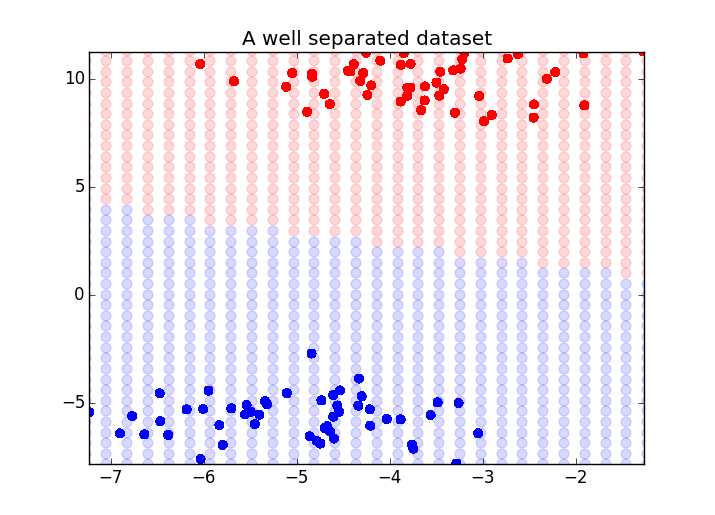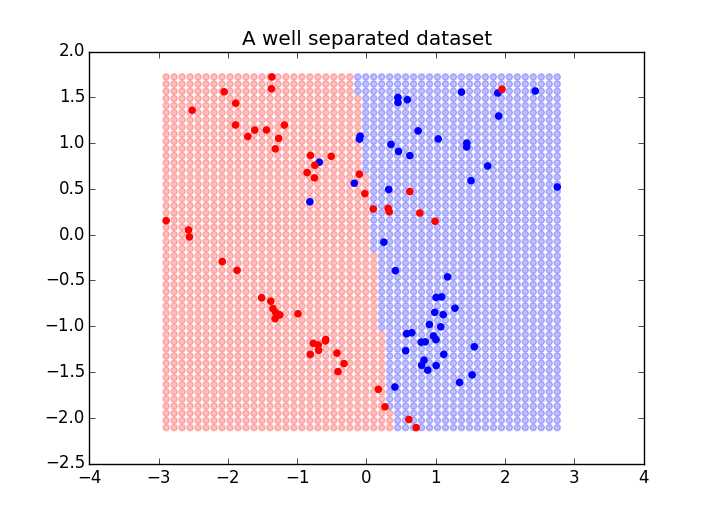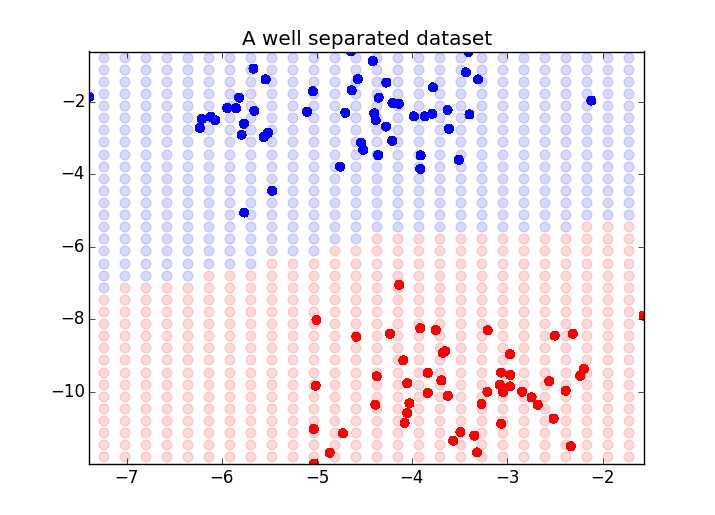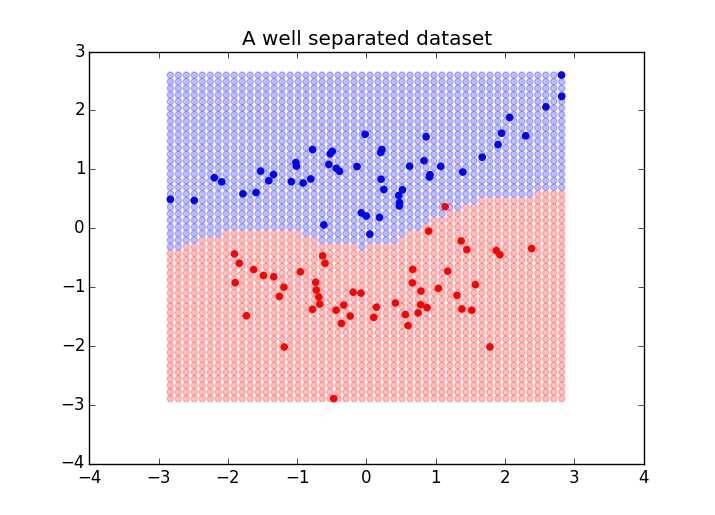标签:
from sklearn import datasets import numpy as np X, y = datasets.make_blobs(n_features=2, centers=2) from sklearn.svm import LinearSVC from sklearn.svm import SVC #测试两种不同的SVM,rbf的核真是太棒了 #svm = LinearSVC() svm = SVC(kernel=‘rbf‘) svm.fit(X, y) ‘‘‘ >>> y array([1, 0, 1, 1, 0, 1, 0, 0, 1, 0, 1, 1, 0, 1, 0, 1, 1, 1, 0, 1, 0, 1, 0, 0, 1, 0, 1, 1, 1, 1, 0, 1, 1, 1, 0, 1, 0, 0, 1, 1, 0, 0, 1, 1, 0, 0, 0, 0, 0, 1, 0, 0, 0, 0, 1, 1, 0, 1, 1, 0, 1, 0, 0, 0, 0, 1, 0, 0, 0, 1, 1, 0, 0, 1, 0, 1, 1, 0, 0, 1, 0, 1, 1, 1, 1, 1, 0, 0, 0, 1, 1, 0, 1, 1, 1, 1, 0, 0, 0, 0]) >>> X[:5] array([[ -7.16607012, 8.67278838], [ -1.9444707 , 4.79203099], [ -8.13823925, 8.61203039], [ -8.46098709, 11.73701048], [ -0.72791284, 6.20893784]]) >>> ‘‘‘ ‘‘‘ Now that we have fit the support vector machine, we will plot its outcome at each point in the graph. This will show us the approximate decision boundary: ‘‘‘ from itertools import product from collections import namedtuple Point = namedtuple(‘Point‘, [‘x‘, ‘y‘, ‘outcome‘]) #寻找X轴、y轴的最小值和最大值 xmin, xmax = np.percentile(X[:, 0], [0, 100]) #等同 X[:,0].min() ymin, ymax = np.percentile(X[:, 1], [0, 100]) ‘‘‘ >>> X[:,0].min() -10.02996504991013 >>> xmin -10.02996504991013 >>> X[:,0].max() 1.6856669658909862 >>> xmax 1.6856669658909862 >>> X[:,1].min() 3.3455301726833886 >>> X[:,1].max() 11.737010478926441 ‘‘‘ #对X,y取值范围内的任何一点,都用SVC进行预测,布成一张网 #下面的20指的是,在哪个取值范围内,选取多少个点 decision_boundary = [] for xpt, ypt in product(np.linspace(xmin-2.5, xmax+2.5, 50),np.linspace(ymin-2.5, ymax+2.5, 50)): #zz = svm.predict([xpt, ypt]) p = Point(xpt, ypt, svm.predict([xpt, ypt])) decision_boundary.append(p) import matplotlib.pyplot as plt f, ax = plt.subplots(figsize=(7, 5)) import numpy as np colors = np.array([‘r‘, ‘b‘]) for xpt, ypt, pt in decision_boundary: ax.scatter(xpt, ypt, color=colors[pt[0]], alpha=.15,s=50) #pt是一个数组,只有一个元素,就是预测的分类(0或1) #特别注意,这是背景色,注意alpha=.15,背景很淡 ax.scatter(X[:, 0], X[:, 1], color=colors[y], s=30) #y是原始值,原始分类 ax.set_ylim(ymin, ymax) ax.set_xlim(xmin, xmax) ax.set_title("A well separated dataset") f.show() #另外一个边界不清晰的例子 X, y = datasets.make_classification(n_features=2,n_classes=2,n_informative=2,n_redundant=0) svm.fit(X, y) xmin, xmax = np.percentile(X[:, 0], [0, 100]) ymin, ymax = np.percentile(X[:, 1], [0, 100]) test_points = np.array([[xx, yy] for xx, yy in product(np.linspace(xmin, xmax),np.linspace(ymin, ymax))]) test_preds = svm.predict(test_points) import matplotlib.pyplot as plt f, ax = plt.subplots(figsize=(7, 5)) import numpy as np colors = np.array([‘r‘, ‘b‘]) ax.scatter(test_points[:, 0], test_points[:, 1],color=colors[test_preds], alpha=.25) ax.scatter(X[:, 0], X[:, 1], color=colors[y]) ax.set_title("A well separated dataset") f.show()




#测试两种不同的SVM,rbf的核真是太棒了(一种会拐弯的边界)
标签:
原文地址:http://www.cnblogs.com/qqhfeng/p/5343217.html